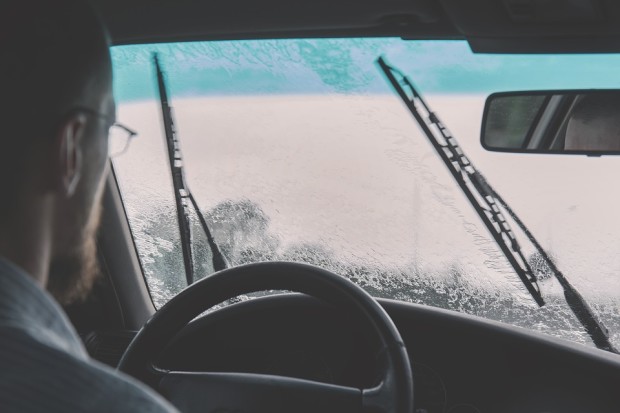Heavy rains can hit the UAE any time of the year and motorists should be prepared to drive safely in such weather conditions. Driving in heavy rain is always full of challenges and the ordeal becomes even greater for young drivers with little or no prior experience of driving in such conditions. While the UAE’s Driving License Acquisition Programme prepares young drivers to face different commuting challenges calmly and safely, driving in bad weather conditions still poses a serious challenge for new drivers.
It is important for drivers to remain calm and follow safe driving practices that they have learned during their Driving License Acquisition Programme. A defensive mindset and attentive approach can make driving in heavy rain less challenging and can help avoid dangerous road situations safely.
Here are 6 most important tips that young drivers should follow to drive safely in heavy rainfall.
Keep Your Headlights Turned On
Regardless of the time of the day or how heavy the rain is, you should keep your headlights turned on whenever driving in rain. The visibility can go down significantly in rainy weather, which can make driving a serious challenge for young drivers. Having your headlights turned on while driving in rain allows you to see better as well as it improves the visibility of your vehicle for other commuters.
Drive Slowly and Avoid Over-speeding
One of the basic safe driving practices that every driver should follow regardless of the weather conditions is to drive within the speed limit of a particular road or highway. It becomes even more important to avoid over-speeding when driving in heavy rain. In fact, drivers should drive at least 5mph to 10mph slower than their usual driving speed whenever they are driving in rain. Over-speeding in heavy rain can lead to extremely dangerous consequences and can cause the vehicle to spin out of control.
Over-speeding can result in hydroplaning (a condition in which a vehicle at high speed starts to float on water), which can be seriously dangerous. It is important to drive at a fairly slow speed to allow oneself enough time to react in a sudden road situation.

Also read: Safe Driving Tips for Young Drivers in the UAE
Don’t Panic if Your Vehicle Hydroplanes
While driving on waterlogged roads, the risk of hydroplaning of a vehicle increases significantly. If this happens to your vehicle, it is important that you don’t lose your calm and drive carefully. It is common with new drivers to panic in such a situation and either push the accelerator hard or apply sudden brakes. Both of these practices are unsafe as a vehicle can spin out of your control, resulting in a seriously dangerous road situation. When faced with a hydroplaning situation, the driver should slow down the speed of the vehicle by taking the foot off the accelerator paddle and maintain attention on the road.
Dear drivers, reduce speed during heavy rain to avoid any hydroplaning.#Weather#YourSecurityOurHappiness#SmartSecureTogether pic.twitter.com/P2gCxWEsIM
— Dubai Policeشرطة دبي (@DubaiPoliceHQ) November 26, 2018
Maintain a Safe Distance from the Vehicle Ahead
You should always leave a safe distance between your vehicle and the vehicle ahead to allow yourself more reaction time while driving in rain. Constant heavy rainfall can reduce the available road traction, which decreases the reaction time of a driver to respond to an emergency situation. In such a scenario, leaving a safe distance between vehicles is important to avoid a dangerous collision if the driver of the vehicle ahead applies sudden brakes.
A failure to leave safe distance between vehicles is also a traffic violation in the UAE for which motorists can face a hefty fine of AED 400 and 4 black points will be issued against their driving license.
Also read: Motorists to Face Hefty Traffic Penalties for Taking Pictures of Rain While Driving
Keep Your Tyres Well-Maintained
Don’t ignore the regular maintenance of your car tyres in rainy season as weak or old tyres can be vulnerable to a sudden blowout situation when driving in heavy rainfall. The tread of such tyres is not deep enough to drive safely on waterlogged roads, which increases the risk of a dangerous road situation induced by a sudden tyre(s) blowout.
It is important to replace such tyres immediately to avoid dangerous road situations. You should also maintain the appropriate air pressure for all four tyres and inspect tyres regularly for a possible leakage that can cause a sudden blowout when driving in heavy rain.

Drive at a Safe Distance from Heavy Vehicles
Visibility can decrease significantly in heavy rain, which can make driving a serious challenge. Driving too close to heavy vehicles can make things even worse as these vehicles have large tyres and can throw water on your vehicle. In a worst-case scenario, it can potentially cause a sudden road accident if the driver loses the sight of the road and surroundings.
Driving at a safe distance from heavy vehicles can also save motorists from becoming collateral damage in case a heavy vehicle suddenly spins out of control or experiences a sudden breakdown situation.
Drive Safe Motorists!
Driving in heavy rain never gets easier for motorists, particularly for young drivers who don’t have much experience of driving in such conditions. Regardless of the weather conditions, the fundamental road safety practice that every driver should follow is to abide by the traffic rules. You can potentially avoid a number of dangerous road situations in bad weather conditions by simply following the traffic rules and by adopting a defensive driving approach.
If you are looking to sell your used car to buy a new one with advanced safety features and improved performance, then don’t forget that with us, you can sell any used car in just 30 minutes while all the post-sale paperwork is handled by SellAnyCar.com’s team.



